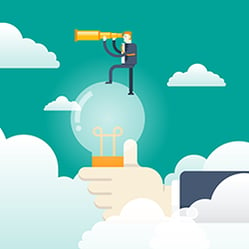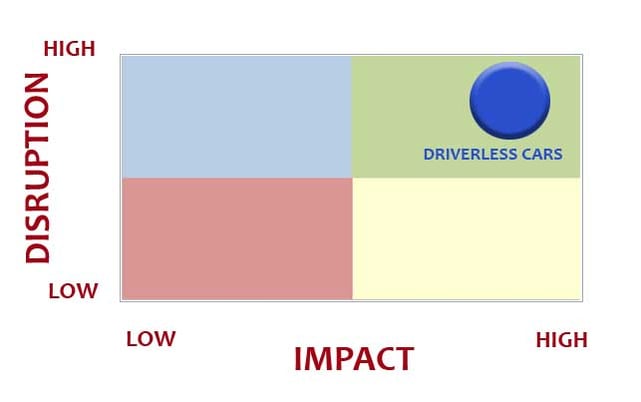Driverless cars.
Water shortages.
Digital printing.
New sources of energy.
Donald Trump…
These are just a few of the potential future global trends that could impact the way we live, eat, drink, work, and get to work over the next 3-5 years. Insightful and evolved business organizations and leaders around the world are struggling with how to assess and build the leadership behaviors, skills and competencies needed to lead in a future world where major disruptions will impact business performance and perhaps even business survivability.
work, and get to work over the next 3-5 years. Insightful and evolved business organizations and leaders around the world are struggling with how to assess and build the leadership behaviors, skills and competencies needed to lead in a future world where major disruptions will impact business performance and perhaps even business survivability.
The graphic below illustrates the relationship between the severities of disruption versus the business impacts of those disruptions. Disruptions come in all different shapes and sizes and take different time intervals to have an impact.
Take driverless cars for example. The disruption to the way we live and work will be high, and the business impact to organizations such as car manufacturers, oil and gas companies, battery companies, technology companies, hospitals, and even beer distributors will be even higher. (Many people think the number one value proposition of driverless cars will be that people will drink and then “drive” in their driverless car).

This diagram illustrates the following disruptions and impacts to business:
High Disruption / High Impact – The most severe situation to be in. Digital photography was a high disruption, high impact to Kodak.
High Disruption / Low Impact – This is a situation that changes organizations but for the most part, they evolve. The Prius is Toyota’s solution to the disruption of the energy crisis. Because of their skills, they minimized the impact.
Low Disruption / High Impact – Airbnb’s technology is low disruption because it wasn’t that different or unique, but the application is having high impact on the hotel business.
Low Disruption / Low Impact – The easiest place to be in an evolving world. Here competitors try to disrupt, but has low impact. Starbucks has launched a pick-up service directly from its app. It’s a low disruption from a technology perspective and really a pretty low impact from the business perspective.
The Leadership Challenge
The challenge from the leadership perspective is that too many organizations aren’t prepared for the disruptions and the impacts in the future. Here are three quick suggestions to develop the organizational an individual leadership behaviors and skills to drive change, and protect from a potential change that may drive you... out of business.
Develop future competencies
HR leaders are very busy measuring competencies and development talent strategies based on the current state of the strategy and the business. My suggestion here is to start thinking about the competencies needed to lead in the future. The skills required to think about the global business ecosystem and other future technology trends are the skills organizations should be looking to develop.
Assess current competencies versus future competencies
What competencies does my organization have today? What will my organization need in the future? The most successful and evolved organizations are designing, developing, and executing assessment centers to measure the competencies and the gaps between today and tomorrow.
Develop to the gaps
Too many organizations are implementing talent development programs to build to yesterday’s skills and competencies. Again, my suggestion is to build to the skills and competencies needed to develop and execute strategyin the evolved and changed world.




